
Copyright © 2008 LITUANUS Foundation, Inc.
Volume 54, No 1 - Spring 2008
Editor of this issue: Violeta Kelertas
 LITHUANIAN QUARTERLY JOURNAL OF ARTS AND SCIENCES
|
ISSN
0024-5089
Copyright © 2008 LITUANUS Foundation, Inc. |
|
Volume 54, No 1 - Spring 2008 Editor of this issue: Violeta Kelertas |
Ode to Walden Pond
The Art of Vytautas O. Virkau
Stasys Goðtautas
In 1962, Vytautas O. Virkau came to Boston to visit Concord and Walden Pond and, as an avid admirer of Henry David Thoreau, made a ritual tour around the pond, admiring its fascinating nature and history. If Virkau had followed his first love, he would have filled his garden with strange new flowers and plants, which he loved with a passion, instead of taking up painting. He confessed once that if he hadn’t become a painter of nature (not a landscape painter), he probably would have been a botanical scientist.
Virkau had another passion that was no less compelling, a passion for drawing and painting. Nature was his sole subject, and from nature he selected flowers, especially water lilies. Human figures, with the exception of some early lithographs, never appear in his paintings. His paintings are dominated by nature, organic and abstract, sometimes including decorative clouds, harking back to the drawings of Odilon Redon, which Virkau saw in the marvelous collection at the Art Institute of Chicago. In the end, he accomplished both: he is a botanist and a painter – a nice combination for an extraordinarily sensitive painter and graphic designer.
Conversing with flowers, in an echo of Jonas Mekas in his Gëliø kalbëjimas (The Discourse of Flowers), Virkau paints them in numerous abstract forms. He is a “hard edge” painter, whose primary colors, especially when he changed oil to acrylic, have no gradation. Virkau calls himself an abstract nature interpreter: “I paint nature, which for me is the most important thing” and geometric and organic still-life forms, executed with a mastery of composition. Even though Virkau was a contemporary of the pop and op art cults, as well as a witness to abstract expressionism and innumerable other “isms”, he remained his own man.
Now that he is retired, Virkau is concentrating on his primal love, nature: the trees, the leaves, and the lines of the branches. And now that he has time, he creates or recreates nature at his farm in Wisconsin, studying and playing with the forms of flowers and plants as Thoreau probably did.
Virkau is an observant artist who captures the delicate botanical world with combinations of pencil, brush and color, a task he accomplishes with “complete ease” as one of his classmates at the School of the Art Institute of Chicago, Herbert Pannnier,2 observed. His canvases are free of tension: his is a plain, simple nature, abstracted with only light and color. Later, writes Harold Haydon, “his paintings fuse landscape and architectural motives with abstract linear elements that derive from cloud formation”3 and the flowers became geometric.
Virkau began showing his drawings and paintings to the Chicago art community more than fifty years ago. He has been part of the Chicago art scene from the days of his studies at the School of the Art Institute of Chicago, where he received an M.F.A. in 1956, to the days when he spent most of his time teaching in various Chicago colleges, including George Williams College in Downers Grove and North Central College in Naperville. He was one of the first post-war émigrés to study at the School of the Art Institute of Chicago, in 1951. A few years later, other Lithuanians joined the famed art school; and by the early 1960s, there were more than a dozen. As an American-Lithuanian, Virkau managed to be engaged in both communities; he shared his talents with Lithuanian artists and intellectuals and at the same time was active in émigré affairs, helping to build the new world that he made his home.
Like so many French painters of the twentieth century, Virkau loved to illustrate books. Some of his book illustrations were among his first steps into the art world. He illustrated authors such as Gogol, Ibsen, Mallarmé and the Lithuanian who wrote in French, Oscar V. de Lubicz-Milosz, whose strange play “Miguel Mañara”, the Don Juan legend in reverse, was the subject of Virkau’s talents.
A significant contribution of his artistic talent to the Lithuanian cause was his cover artwork and design of the academic journals Lituanus and Metmenys (Patterns), which he designed for decades. He also designed numerous books and book jackets for AM&M publications.
In later years, beginning in 1979, he became obsessed with ex libris, or bookplates, and designed somewhere near 400 of them. The bookplates provide an opportunity to appreciate both his drawing talent and his subtle imagination. Each one is a little piece of art reflecting the owner’s interests. He created ex libris for Czesùaw Miùosz and Josef Brodsky, both of whom later became Nobel Prize winners.
Virkau is a humble artist, an aesthete and scrupulous artisan of his craft. He weaves nature, his love since childhood, into his paintings, using complex patterns of design, adjustments in spatial values and color to express his involvement with plant forms. His works disclose an exquisite mastery of composition.
Stasys Goðtautas
1. This
is the second time that Lituanus
honors Vytautas O. Virkau. The first time was in the fall-winter issue
of 1964.
2. Chicago Tribune, June 30, 1963.
3. Chicago Sun-Times, March 13, 1981.
Vytautas O. Virkau:
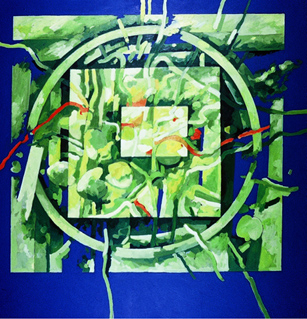
Circle of Freedom, 46”x 44”, acrylic on canvas, #1/1966
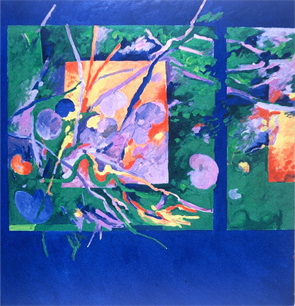
Pond Foliage, 44”x 42”, acrylic on canvas, #3/1965
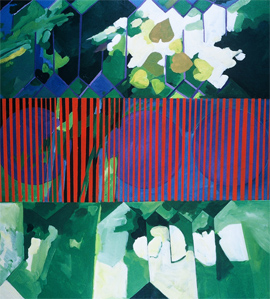
Faceted Landscape, 42”x 40”, acrylic on canvas, #18/1967
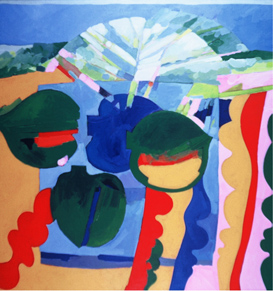
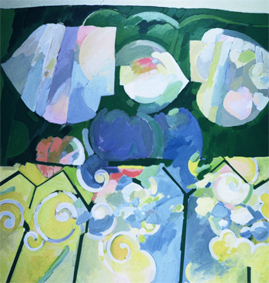
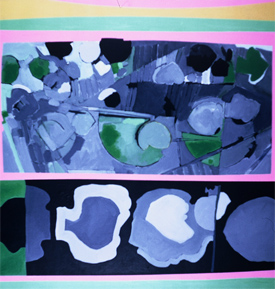
Oysters and Pebble, 42”x 40”, acrylic on canvas, #1/1970
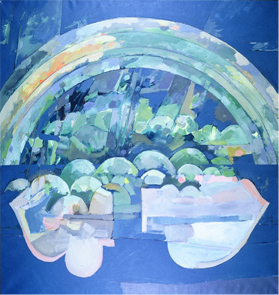
Lake Rainbow, 42”x 40”, acrylic on canvas, #1/1972
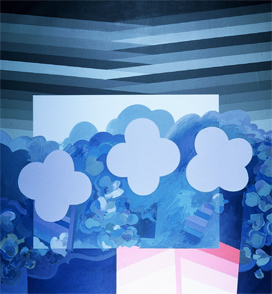
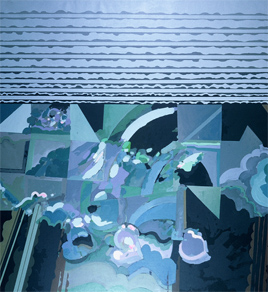
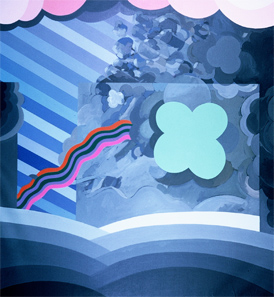
Open Book, 42”x 40”, acrylic on canvas, #9/1973